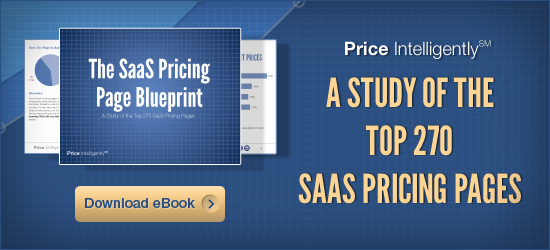The most important part of running a SaaS business, besides engineering the product of course, is creating a strong revenue model that allows you to efficiently pull in cash and keep the lights on. Developing your revenue model, like pricing, should be a continual process for SaaS companies because of the often unpredictable and dynamic nature of SaaS business. We often find refreshing a stale revenue model to be the key to unlocking additional profits for companies, especially as your product improves, your customers’ needs change, and your company expands.
There can be a lot to consider when developing or revamping a revenue model, including the number of plans you will support, subscription length, and whether or not to offer custom plans or free trials. These considerations can make it challenging to determine an optimal structure, but like we always say with pricing, your decisions will be stronger when grounded in hard data. Therefore, we’ve collected data on the revenue models of over 270 different SaaS companies for you to use as a foundation for your own revenue model. Of course, keep in mind that every business and company is unique so you should treat these more as general guidelines rather than hard and fast rules.
Number of Plans to Offer
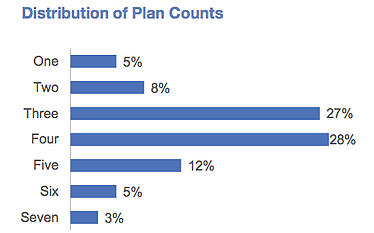
Offering multiple plans is a great way to cater to different customer perceptions of value and take advantage of a price differentiation strategy, but too many choices can appear daunting and turn potential customers away. A good rule of thumb is to have as many tiers as you do buyer personas, so that the features and price point of each tier can be tailored to one particular persona. (For more on how to do that, check out this guide to value based pricing). Our research in the SaaS market shows most companies find that offering 3-4 tiers provides the right number of options.
Subscription Length
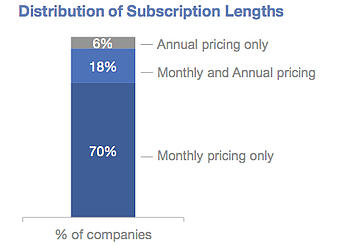
For subscription models, most SaaS companies offer monthly pricing plans, which are popular because the smaller numbers appear friendlier and the lack of long-term commitment reduces the pressure on potential buyers. However, providing annual subscriptions may secure you more business upfront and reduce churn, the mortal enemy of SaaS. You can compromise between the two options by offering both a monthly and annual plan, with the price of the annual plan positioned at a slight discount to the price of the monthly plan. This allows you to cater to two different types of buyers: those who are willing to pay extra for the flexibility of a monthly plan and those who love your product and would appreciate a slight discount for their loyalty in choosing the annual plan.
Custom Plans
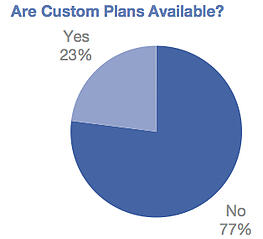
Your decision to offer custom plans will rely heavily on the flexibility of your software and the bandwidth of your development team. If your team has the capacity to tailor plans to specific customers, then promoting your product’s customizability can be a fantastic way to encourage high-profile clients to contact you directly if they require special feature packages to accommodate their needs. If your team doesn’t have the bandwidth to develop custom plans, don’t worry. Over 75% of the SaaS companies we analyzed choose to avoid advertising custom plans, so it’s not the end of the world if your team doesn’t have the time to retool and adapt your offerings.
Free Trial
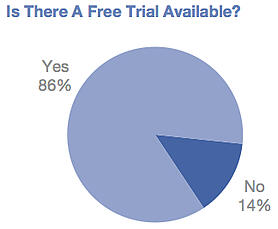
86% of SaaS companies offer a free trial of their product, which makes sense given that they are one of the best ways to increase your paid user base. Free trials allow you to effectively demonstrate the value of your product, increase your customers’ willingness to pay, and force your customers to make a purchasing decision at the end of the trial. Therefore, if you’re able to demonstrate strong value in your product throughout the free trial period, customers will want to subscribe simply to avoid the feelings of loss associated with giving up your product. Free trials are also especially relevant to SaaS companies because the marginal cost of an additional software license is negligible, which makes them a fantastic and inexpensive marketing strategy with the potential for massive ROI.
Conclusion
As we mentioned at the beginning of this post, every company is unique and will require a different revenue model to be successful. However, the data we’ve collected provides insight into current SaaS industry trends and should provide a solid foundation for the model that best suits your business.
If you’re interested in a more personalized consultation for your company, feel free to reach out to us for a free Price Optimization Assessment. Otherwise, check out our latest eBook, the SaaS Pricing Page Blueprint, for additional data and analysis on building an optimal pricing page and revenue model.
- SEO Powered Content & PR Distribution. Get Amplified Today.
- Platoblockchain. Web3 Metaverse Intelligence. Knowledge Amplified. Access Here.
- Source: https://www.priceintelligently.com/blog/bid/191415/setting-up-your-revenue-model-for-profit-maximization


